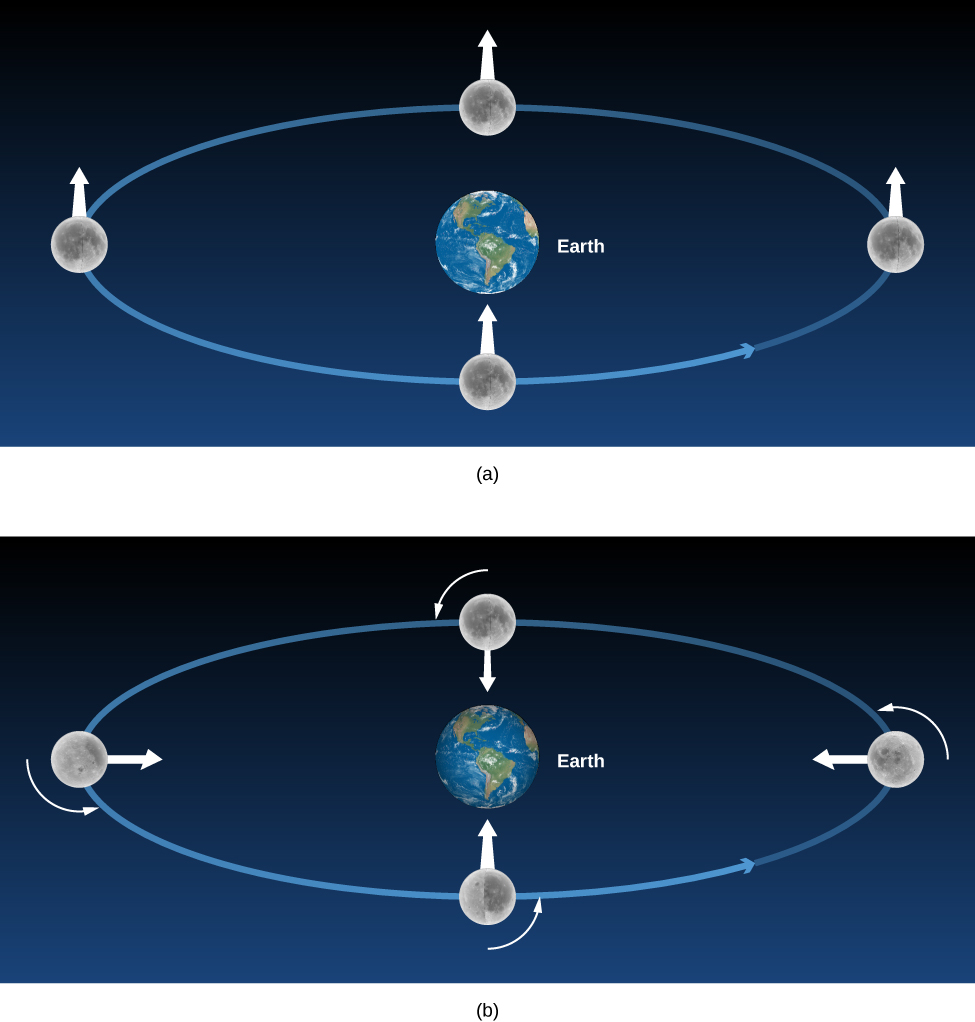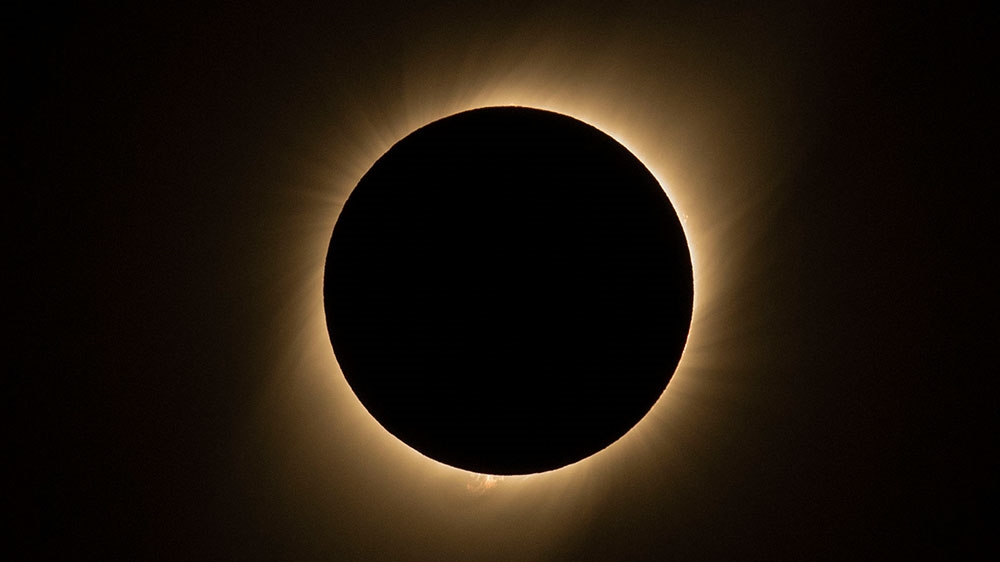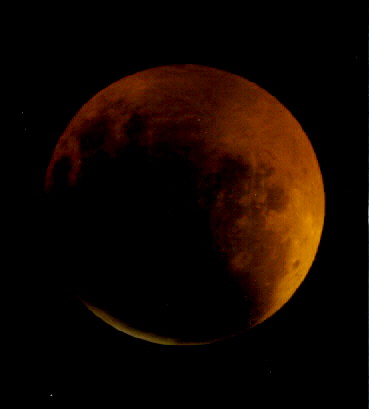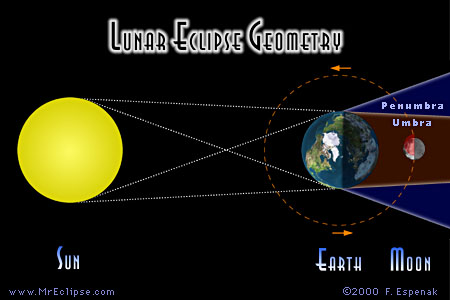Julian Date: 2459265.18
2020-2021: XCV
"Sent on purpose."
THE DAILY ASTRONOMER
Monday, February 22, 2021
Exploratorium XXVIII: Lunar Eclipse Questions
During a total lunar eclipse, would a moon-based observer see a solar eclipse like we would see on Earth when the moon crosses in front of the Sun?
Observers on the moon's surface would not see the same type of solar eclipse that we see on Earth when the moon moves directly in front of the Sun. First of all, Earth does not appear to move across the moon's sky. As the moon is tidally locked with Earth, our planet maintains the same position in the moon's sky (apart from minor shifts related to secondary motion effects.) Astronomers refer to this tidal lock as synchronous rotation, meaning that the moon's rotational period is equal to its revolutionary period. Consequently, the moon directs the same face toward Earth as it revolves around it. Although the moon has no dark side, Pink, it does have a "far side," a side which never faces Earth. Observers on this far side would never see our home planet. Those on the near side would see Earth occupy only one position.

Synchronous rotation: the moon's rotational period is equal to its revolutionary period. Any moon-based observer would either not see Earth at all (if he/she were on the far side of the moon) or would only see the Earth in one location in the moon's sky.
The second issue pertains to angular diameter. During a total solar eclipse, the moon covers the Sun precisely because their angular diameters are just about equal. Although the Sun's diameter is about 400 times greater than the Moon's, it is also 400 times farther away. Both angular diameters equal approximately one-half a degree. * When seen from the moon, Earth's angular diameter ranges from 1.8 - 2 degrees, making it appear significantly larger than the moon. So, during a total lunar eclipse as seen on Earth, a moon-based observer would see the Sun appear to move behind Earth. However, that observer would not witness a spectacle akin to a total solar eclipse: Instead, the Sun would simply vanish behind Earth before slowly emerging into view again.

During a total lunar eclipse, an observer on the moon would not see exactly the same type of solar eclipse we Earthlings sometimes witness. Earth appears much larger than the Sun from the perspective of the moon's surface. The Sun would appear to simply vanish behind Earth.
Why does the moon actually appear reddish during a total solar eclipse and how does that relate to the Danjon Scale?
Because the Sun is always shining on Earth, the planet always projects a shadow cone into space. (We live in the base of that cone every night.) During a lunar eclipse, the full moon encounters this shadow. During an eclipse, the moon appears red because it is reflecting the red light which is constantly directed into the cone. That light derives from the sunsets and sunrises that occur around the planet's edge.
The Danjon Scale, devised by French astronomer André-Louis Danjon (1890-1967), measures the relative brightness and coloration of lunar eclipses. Danjon established this scale to try to find a correlation between the appearance of lunar eclipses and the solar cycle.**
The Danjon Scale has a range between 0 - 4:
- 0 Very dark eclipse. Moon might even not be visible during totality.
- 1 Brown or grey coloration.
- 2 Rust-colored eclipse. Also deep red. Distinct color differential, with the central moon dark and the outer edge brighter and more colorful.
- 3 Brick red eclipse. Yellowish rim around umbral shadow
- 4 Very bright eclipse. Copper red or orange eclipse. Umbral shadow has a bluish edge
The above image shows two eclipses, one from May 2003 and the other from November 2003. The May eclipse image would be a 2 on the Danjon scale; the November eclipse would rate a 4.
Danjon values cannot be predicted. Instead, they are observed during the moment of greatest eclipse. Atmospheric factors tend to affect this rating more than any other consideration. For instance, the December 9, 1992 lunar eclipse, seen below, was quite dark due to the 1991 eruption of Mount Pinatubo.
 ]
]
Particles scattered into Earth;s atmosphere by a volcanic eruption in 1991 caused the 1992 lunar eclipse to appear quite dark, as seen in the 4-minute time exposure seen above. To the unaided eye, the reddish coloration we see at the right side of this image would have been far less distinct.
During the next lunar eclipse on November 19, 2021, you should try to determine the Danjon value for yourself during the maximum eclipse phase. While that eclipse is technically partial, the reddish coloration will still be apparent because most of the moon will pass into the umbra.
Can any of the planets be eclipsed by Earth's shadow?
The other planets will never seven stray close to Earth's shadow cone. The inferior planets Mercury and Venus are much closer to the Sun than Earth and wouldn't venture anywhere near the shadow cone, anyway. The minimum possible separation distance between Earth and Mars can never be less than 32 million miles: well past the shadow cone tip, which is about 840,000 miles from Earth.
You mentioned that Saros Cycles have finite durations. Can astronomers know when future Saros cycles will occur?
Absolutely. Astronomers know about Saros that will begin centuries in the future. For instance, Lunar Saros 180 will begin with a partial penbumbral eclipse on August 28 , 2827 and will end with another partial penumbral eclipse on October 3, 4089.
Lunar Saros 150 began on May 25, 2013 and will end on June 30, 3275.
Lunar Saros 151 will begin on June 6, 2096 and won't end until July 13, 3358.
The moon is moving away from Earth. Will lunar eclipses ever cease?
Well, lunar eclipses will eventually cease after the Sun ends its life cycle. Or, the expanding red giant sun could incinerate Earth, putting an end to lunar eclipses as well. Of course, those scenarios are billions of years in the future. The moon is receding from Earth at the rate of 3.8 centimeters per year. This gradual, but inexorable recession will never push the moon beyond Earth's shadow cone. We should note that this recession rate is not constant and will be reduced dramatically once the oceans vanish on Earth in about 1.2 billion years from now as a consequence of Earth's rising temperature related to the increasing solar luminosity.
When will the next lunar saros cycle come to an end?
Lunar Saros 110 will end on July 18, 2027. This Saros cycle started with a penumbral eclipse on May 28, 747 . The last eclipse in the series will be penumbral as well, meaning that it will pass unnoticed by most. The previous lunar Saros cycle (109) ended on August 8, 1998. The following Saros Cycle (112) will end on July 19, 2092.
Isn't there always a solar eclipse associated with a lunar eclipse? When will that solar eclipse occur that is associated with the November 2021 eclipse and will we see it?
Yes. A solar eclipse either follows or precedes a lunar eclipse.
The November 2021 lunar eclipse will be followed by a solar eclipse on December 4, 2021. However, we here in New England will be far away from the totality path, which slices across Antarctica.
*This value varies as the moon's distance from Earth and Earth's from the Sun are not constant.
**Many astronomers believe that the solar cycle does exert some influence in this coloration.





.jpg%22&N=Tom_Ruen_-_Lunar_eclipses_in_2003_(pd).jpg)
 ]
]